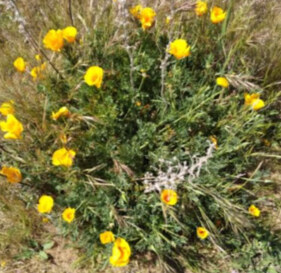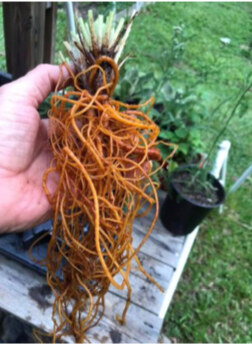Eschscholzia californica
Download info sheetSome of the other names which this herb are known by include; golden poppy, California golden poppy, copa de oro (cup of gold) or dedal de oro (thimble of gold), and flame flower. It is a member of the Papaveraceae family, to which the ‘opium poppy belongs’, though this is ‘non-narcotic’ relative. It is indigenous to the western US states (from South Washington, down to Baja Sur, from the Channel Islands and Pacific coastline east to the Great Basin and regions of the Sonoran Desert). From 1903, it became the state flower of California. It is very easy to grow and it has spread to most countries; as a beloved garden plant, or as an invasive weed. Image: growing wild on a Cromwell roadside, Karina Hilterman
Image: growing wild on a Cromwell roadside, Karina Hilterman
Identification & Cultivation: Depending on growing conditions, they generally grow between 15-30cmsand may be an annual in a cold climate, or sometime continue growing intoanother year. The soft foliage, glaucous blue-green, branches alternately. Each flower is on a single stem, the petals are silky and the variable in colour; ranging orange, to yellow or red. They close up at night or on gloomy days, opening to the next sunny day. After the petals drop, a long, slender seed head may develop. When mature splits open, with a snapping sound, which scatters many small dark seeds around. The hard to tackle genus name is from the dedication to Johann Fredrich von Eschscholtz, a German botanist from the early 1800’s.
Parts used: Usually the aerial parts, though the roots may be used, or the ‘whole plant’; it is considered that a fresh plant tincture is the best extraction method.
Constituents: Antioxidants, flavonoids, including zeaxanthin, magniflorine, quercetin, isorhamnetin, and rutin. Alkaloids including sanguinarine, berberine, protopine, cryptopine, allocryptopine, allocrytine, chelidonine, californidine, lauroscholtzine, and eschscholtzine. Flavone glycosides. Unlike some other Papaver alkaloids, the Californian Poppy has a sap that contains a different class of alkaloids to the addictive ‘opium poppy’ and it does not have a narcotic effect on the human body. It can provide effective relief, without the concerns of addiction. There is another family member which also provides this; Corydalis ambigua, known as Yan Hu Suo in Traditional Chinese Medicine; it is generally considered to be about 1/10th the strength of morphine, without the negative issues, such as constipation and addiction.
Therapeutic Actions: Analgesic, anti-histamine, anti-spasmodic, anxiolytic, febrifuge, nervine, sedative, uterine stimulant. Considered to be an effective herb for treating the nervous system problems; insomnia, neuropathy, anxiety and restlessness. Image: Roots washed for tincturing; Max Burgess
Image: Roots washed for tincturing; Max Burgess
Medicinal uses: California poppy is considered safe for all ages; including for children who suffer with hyperactivity, insomnia, pain and restlessness or anxiety. Preparing a syrup of the flowers is considered the preferred treatment. “California poppy is often included in pain remedies. It treats headache, toothache, and spasms of the gastrointestinal and urinary tracts. An anti spasmodic and smooth muscle relaxant California poppy eases nervous
tension and is a great sleep aid especially when body aches or other minor pain conditions exist. California poppy is mildly sedative with analgesic properties that react with GABA receptors in the brain, relaxing without suppressing the CNS. I tincture the whole plant I also dry and use in teas”.
Michael Moore, herbalist, says that taking an excessive dose, can lead to a mild-hangover feeling, suggesting that is not a herb to seek ‘pleasurable experiences’; a herb which is functional, not fun. Topical use, it can be used to treat fungal infections, like ringworm; use a decoction or crushed flowers…
Dosage: Infusion of dried herb; 2-4gm up to 3 times daily, Tincture (1:10 extract using 45%ethanol) 2-4mls up to 3 times daily, fluid extract (25%) 1-2mls up to 3 times daily.
Culinary & Other Uses: The Indigenous peoples of the areas where this herb grows used the seeds in their cooling and the pollen as a cosmetic, in addition to using the whole plant for medicinal uses. Use fresh flowers in salads; add to baking; sweet or savoury. Pick just before using, as they wilt quickly.
History & Mystery: It is referred to in Chumash legends, one as follows: On earth, when animals were people, Lizard described to Coyote the California poppies out on the islands: “When you see it, it is as if the sun itself is on the ground.”
As the early Spanish colonists sailed in, they saw hillsides of flowering poppies and called it “the land of fire”. In addition, because the flowers close in the evening, or on cloudy days, they called it ‘Dormidera’. It does not produce nectar, though a proliferation of pollen, loved by insects…
Copa de Oro poem (PDF, 161.63 kB) by Ina Coolbrith, first poet laureate of California (1841-1928)
References:https://en.wikipedia.org/wiki/Eschscholzia_californica; Max Burgess; Materia Medica of Western Herbs, Carole Fisher, www.growforagecookferment.com/foraging-for-wild-poppies/
Prepared for the Herb Federation of New Zealand’s Herb Awareness Month 2024. Enquiries: www.herbs.org.nz
Advisory Note: This text is given as a general guidance. If any adverse reactions occur or symptoms persist, please contact a qualified medical herbalist or medical doctor immediately.

